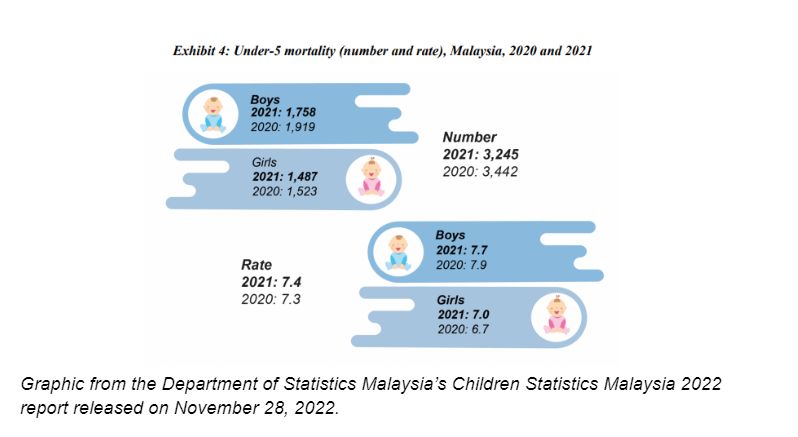KUALA LUMPUR, Dec 1 – Malaysia reported a slight increase in mortality rate of children under-five for the year 2021 to 7.4 per 1,000 live births from 7.3 per 1,000 live births in the previous year, according to the Department of Statistics Malaysia (DOSM).
The increase was primarily attributed to a rise in mortality rate for girls, which went up to 7 (per 1,000 live births) in 2021 from 6.7 in 2020. The mortality rate for boys decreased to 7.7 in 2021 compared to 7.9 in the previous year.
The leading medically-certified cause of under-five deaths was conditions originating in the perinatal period at 37 per cent, an increase from 35.2 per cent in 2020. These conditions include complications from pregnancy, labour and delivery, respiratory and cardiovascular disorders, foetal growth disorders, and birth trauma.
This was followed by congenital malformations or birth defects, deformations and chromosomal abnormalities at 29.9 per cent, pneumonia (2.1 per cent), Covid-19 infection (1.5 per cent), and transport accidents (1.1 per cent).
Other causes include leukaemia (1 per cent), cerebrovascular diseases (0.6 per cent), accidental drowning and submersion (0.5 per cent), diseases of the liver (0.5 per cent), and malignant neoplasm or cancerous tumour of the meninges (tissues that cover the brain and spinal cord), brain and other parts of the central nervous system (0.4 per cent).
One of the Sustainable Development Goals (SDG) indicators related to children is to end preventable deaths of newborns and children under five years of age by 2030, with countries aiming to reduce neonatal mortality to at least as low as 12 per 1,000 live births and under-five mortality to at least as low as 25 per 1,000 live births.
Malaysia has achieved the under-five mortality rate target since 1984.
The country’s neonatal mortality rate, or deaths of infants aged less than 28 days, stood at 4.1 per 1,000 live births in 2021, an increase from 3.9 per 1,000 live births in 2020.
Among states, the neonatal mortality rate was the highest in Sabah at 5.6 per 1,000 live births in 2021, followed by the Federal Territory of Labuan (5.3 per 1,000 live births), Perlis (5.2 per 1,000 live births) and Kelantan (5.2 per 1,000 live births).
Malaysia’s live births rate, or births with signs of life during delivery even for a short period, for the year 2021 was lower than the previous two years at 439,744 or 13.5 per 1,000 population.
In 2020, the number of live births was 471,504 or 14.5 per 1,000 population, while in 2019, the rate was at 489,863 live births or 15.1 per 1,000 population.
Life expectancy at birth also reported a decline to 73.4 in 2021 from 74.5 the previous year and 74.7 in 2019.
The rate of moderate and severe malnutrition in children under-five recorded declines in 2021. The moderate malnutrition rate was 1.3 per cent, a drop from 1.5 per cent in 2020, while the severe malnutrition rate for children in the age group was 0.2 per cent versus 0.3 per cent the previous year.
The highest severe malnutrition rate was in Labuan at 1.2 per cent. In Sarawak and Perlis, the severe malnutrition rates were both at 0.7 per cent, while in Pahang, the severe malnutrition rate was at 0.6 per cent. Other states reported rates of less than 0.5 per cent, with Putrajaya recording zero cases of severe malnutrition.
The rates for moderate malnutrition were higher across states, with Sarawak reporting the highest rate at 3 per cent. This is followed by Pahang and Perak at 2.9 per cent, Labuan (2.1 per cent), Negeri Sembilan (2 per cent), Perlis (1.7 per cent) and Sabah (1.6 per cent).
Eight states and federal territories in total reported moderate malnutrition rates above the national level of 1.3 per cent.

In terms of immunisation coverage for infants, all immunisation coverage recorded a decline in 2021 except bacillus calmette-guerin (BCG), which remained at 98.8 per cent.
There are five immunisations given to infants namely BCG, poliomyelitis (polio), diphtheria, tetanus and pertussis (DTP), haemophilus influenzae type B (HIB) and hepatitis B.
Three immunisations namely polio, DTP and HIB showed a decrease of 3.5 percentage points to 94.2 per cent in 2021 from 97.7 per cent in 2020. Meanwhile, vaccinations for hepatitis B decreased by 8.2 percentage points to 93 per cent in 2021 compared to 101.2 percent in 2020.
For Covid-19 vaccines, there were 2.74 million recipients aged five to 17 years old who had completed two doses in 2021.
Human papillomavirus (HPV) immunisations for Form 1 girls reported a huge 84 per cent drop in 2021 to 31,888 compared to 200,981 in 2020.
Former health minister Khairy Jamaluddin in September said Malaysia had “lost a bit of ground” in HPV vaccination for teenage girls from 2020 to 2021 during the pandemic.
However, Khairy had attributed the decline in HPV vaccinations, particularly in 2021, to global HPV vaccine shortage instead of the Covid-19 pandemic.
Khairy said the Ministry of Health (MOH) was committed to a catch-up programme to cover girls who missed their shots of the HPV vaccine that prevents cervical cancer.
New HIV/AIDS cases among children and teenagers until 19 years of age also reported a decline in 2021, with new HIV cases falling by 25 per cent to 99 cases from 132 cases the previous year, and AIDS declining by 10 per cent to 18 cases from 20 cases in 2020.








